Comparison of the Field Trapping Ability of MgB2 and Hybrid Disc-Shaped Layouts
Abstract
:1. Introduction
2. Materials and Methods
2.1. Superconducting Sample
2.2. Experimental Details
2.3. Modelling
3. Results and Discussion
3.1. Experimental Results
3.2. Critical Current Density Evaluation and Validation of the Numerical Model
- Starting from the curve vs. reported in Figure 5, we evaluated the difference between the experimental and computed trapped fields, i.e., (= − ), where is the measured magnetic flux density presented in Section 3.1 and is the computed values obtained fitting the curve with a polynomial fit. In the first iteration, the index i was set to 0;
- We applied Chen’s formula (i.e., Equation (6)) to evaluate
- We built a new vs. curve adding to the values calculated in the previous step;
- We fitted the vs. by a polynomial law;
- We inserted the new vs. dependence in the numerical procedure and achieved new and vs. curves. We repeated the whole procedure several times ().
3.3. Trapped Fields in Hybrid Samples
4. Conclusions
Author Contributions
Funding
Institutional Review Board Statement
Informed Consent Statement
Data Availability Statement
Acknowledgments
Conflicts of Interest
References
- Vakaliuk, O.; Werfel, F.; Jaroszynski, J.; Halbedel, B. Trapped field potential of commercial Y-Ba-Cu-O bulk superconductors designed for applications. Supercond. Sci. Technol. 2020, 33, 095005. [Google Scholar] [CrossRef]
- Motoki, T.; Miwa, M.; Semba, M.; Shimoyama, J.i. Greatly Improved Trapped Magnetic Fields of REBCO Melt-Grown Bulks Through Reductive High-Temperature Post-Annealing. IEEE Trans. Appl. Supercond. 2023, 33, 6800205. [Google Scholar] [CrossRef]
- Ainslie, M.; Huang, K.; Fujishiro, H.; Chaddock, J.; Takahashi, K.; Namba, S.; Cardwell, D.; Durrell, J. Numerical modelling of mechanical stresses in bulk superconductor magnets with and without mechanical reinforcement. Supercond. Sci. Technol. 2019, 32, 034002. [Google Scholar] [CrossRef]
- Huang, K.Y.; Shi, Y.; Srpčič, J.; Ainslie, M.D.; Namburi, D.K.; Dennis, A.R.; Zhou, D.; Boll, M.; Filipenko, M.; Jaroszynski, J.; et al. Composite stacks for reliable> 17 T trapped fields in bulk superconductor magnets. Supercond. Sci. Technol. 2019, 33, 02LT01. [Google Scholar] [CrossRef]
- Faraji, F.; Majazi, A.; Al-Haddad, K. A comprehensive review of flywheel energy storage system technology. Renew. Sustain. Energy Rev. 2017, 67, 477–490. [Google Scholar] [CrossRef]
- Koohi-Kamali, S.; Tyagi, V.; Rahim, N.; Panwar, N.; Mokhlis, H. Emergence of energy storage technologies as the solution for reliable operation of smart power systems: A review. Renew. Sustain. Energy Rev. 2013, 25, 135–165. [Google Scholar] [CrossRef]
- Miryala, M. (Ed.) High-Tc Superconducting Technology: Towards Sustainable Development Goals, 1st ed.; Jenny Stanford Publishing: Singapore, 2021. [Google Scholar]
- Luongo, C.A.; Masson, P.J.; Nam, T.; Mavris, D.; Kim, H.D.; Brown, G.V.; Waters, M.; Hall, D. Next generation more-electric aircraft: A potential application for HTS superconductors. IEEE Trans. Appl. Supercond. 2009, 19, 1055–1068. [Google Scholar] [CrossRef]
- Abrahamsen, A.B.; Magnusson, N.; Jensen, B.B.; Runde, M. Large superconducting wind turbine generators. Energy Procedia 2012, 24, 60–67. [Google Scholar] [CrossRef]
- Yamaguchi, S.; Kanda, M. A proposal for a lightweight, large current superconducting cable for aviation. Supercond. Sci. Technol. 2020, 34, 014001. [Google Scholar] [CrossRef]
- Kalsi, S.S.; Storey, J.G.; Brooks, J.M.; Lumsden, G.; BadcockSenior, R.A. Superconducting synchronous motor development for airplane applications-mechanical and electrical design of a prototype 100 kW motor. IEEE Trans. Appl. Supercond. 2023, 33, 5201806. [Google Scholar] [CrossRef]
- Durrell, J.H.; Ainslie, M.D.; Zhou, D.; Vanderbemden, P.; Bradshaw, T.; Speller, S.; Filipenko, M.; Cardwell, D.A. Bulk superconductors: A roadmap to applications. Supercond. Sci. Technol. 2018, 31, 103501. [Google Scholar] [CrossRef]
- Huang, K.Y.; Hlásek, T.; Namburi, D.K.; Dennis, A.R.; Shi, Y.; Ainslie, M.D.; Congreve, J.V.; Plecháček, V.; Plecháček, J.; Cardwell, D.A.; et al. Improved trapped field performance of single grain Y-Ba-Cu-O bulk superconductors containing artificial holes. J. Am. Ceram. Soc. 2021, 104, 6309–6318. [Google Scholar] [CrossRef]
- Fujishiro, H.; Mochizuki, H.; Ainslie, M.; Naito, T. Trapped field of 1.1 T without flux jumps in an MgB2 bulk during pulsed field magnetization using a split coil with a soft iron yoke. Supercond. Sci. Technol. 2016, 29, 084001. [Google Scholar] [CrossRef]
- Fagnard, J.F.; Morita, M.; Nariki, S.; Teshima, H.; Caps, H.; Vanderheyden, B.; Vanderbemden, P. Magnetic moment and local magnetic induction of superconducting/ferromagnetic structures subjected to crossed fields: Experiments on GdBCO and modelling. Supercond. Sci. Technol. 2016, 29, 125004. [Google Scholar] [CrossRef]
- Cientanni, V.; Ainslie, M.D.; Fujishiro, H.; Takahashi, K. Modelling higher trapped fields by pulsed field magnetisation of composite bulk MgB2 superconducting rings. Supercond. Sci. Technol. 2021, 34, 114003. [Google Scholar] [CrossRef]
- Yamamoto, A.; Ishihara, A.; Tomita, M.; Kishio, K. Permanent magnet with MgB2 bulk superconductor. Appl. Phys. Lett. 2014, 105, 032601. [Google Scholar] [CrossRef]
- Berger, K.; Koblischka, M.R.; Douine, B.; Noudem, J.; Bernstein, P.; Hauet, T.; Lévêque, J. High Magnetic Field Generated by Bulk MgB2 Prepared by Spark Plasma Sintering. IEEE Trans. Appl. Supercond. 2016, 26, 6801005. [Google Scholar] [CrossRef]
- Zhang, Z.; MacManus-Driscoll, J.; Suo, H.; Wang, Q. Review of synthesis of high volumetric density, low gravimetric density MgB2 bulk for potential magnetic field applications. Superconductivity 2022, 3, 100015. [Google Scholar] [CrossRef]
- Zou, J.; Ainslie, M.D.; Fujishiro, H.; Bhagurkar, A.G.; Naito, T.; Babu, N.H.; Fagnard, J.F.; Vanderbemden, P.; Yamamoto, A. Numerical modelling and comparison of MgB2 bulks fabricated by HIP and infiltration growth. Supercond. Sci. Technol. 2015, 28, 075009. [Google Scholar] [CrossRef]
- Miryala, M.; Arvapalli, S.S.; Sakai, N.; Murakami, M.; Mochizuki, H.; Naito, T.; Fujshiro, H.; Jirsa, M.; Murakami, A.; Noudem, J. Complex pulse magnetization process and mechanical properties of spark plasma sintered bulk MgB2. Mater. Sci. Eng. B 2021, 273, 115390. [Google Scholar] [CrossRef]
- Muralidhar, M.; Shadab, M.; Srikanth, A.S.; Jirsa, M.; Noudem, J. Review on high-performance bulk MgB2 superconductors. J. Phys. D Appl. Phys. 2023, 57, 053001. [Google Scholar] [CrossRef]
- Prikhna, T.; Eisterer, M.; Gawalek, W.; Mamalis, A.G.; Kozyrev, A.; Kovylaev, V.; Hristoforou, E.; Weber, H.W.; Noudem, J.G.; Goldacker, W.; et al. Structure and functional properties of bulk MgB2 superconductors synthesized and sintered under pressure. Mater. Sci. Forum 2014, 792, 21–26. [Google Scholar] [CrossRef]
- Gajda, G.; Morawski, A.; Diduszko, R.; Cetner, T.; Hossain, M.; Gruszka, K.; Gajda, D.; Przyslupski, P. Role of double doping with C and RE2O3 oxides on the critical temperature and critical current of MgB2 phase. J. Alloys Compd. 2017, 709, 473–480. [Google Scholar] [CrossRef]
- Gajda, G.; Filar, K.; Morawski, A.; Gajda, D.; Przyslupski, P. The effect of C and (Er, Sm, Eu)2O3 doping and high isostatic pressing on superconducting properties of MgB2 phase and volume of cylindrical MgB2 ceramic samples. J. Alloys Compd. 2023, 938, 168526. [Google Scholar] [CrossRef]
- Dadiel, J.L.; Naik, S.P.K.; Pęczkowski, P.; Sugiyama, J.; Ogino, H.; Sakai, N.; Kazuya, Y.; Warski, T.; Wojcik, A.; Oka, T.; et al. Synthesis of dense MgB2 superconductor via in situ and Ex situ spark plasma sintering method. Materials 2021, 14, 7395. [Google Scholar] [CrossRef]
- Xing, Y.; Bernstein, P.; Muralidhar, M.; Noudem, J. Overview of spark plasma synthesis and sintering of MgB2 superconductor. Supercond. Sci. Technol. 2023, 36, 115005. [Google Scholar] [CrossRef]
- Bhagurkar, A.; Yamamoto, A.; Anguilano, L.; Dennis, A.; Durrell, J.; Babu, N.H.; Cardwell, D. A trapped magnetic field of 3 T in homogeneous, bulk MgB2 superconductors fabricated by a modified precursor infiltration and growth process. Supercond. Sci. Technol. 2016, 29, 035008. [Google Scholar] [CrossRef]
- Naito, T.; Ogino, A.; Fujishiro, H. Potential ability of 3 T-class trapped field on MgB2 bulk surface synthesized by the infiltration-capsule method. Supercond. Sci. Technol. 2016, 29, 115003. [Google Scholar] [CrossRef]
- Fuchs, G.; Häßler, W.; Nenkov, K.; Scheiter, J.; Perner, O.; Handstein, A.; Kanai, T.; Schultz, L.; Holzapfel, B. High trapped fields in bulk MgB2 prepared by hot-pressing of ball-milled precursor powder. Supercond. Sci. Technol. 2013, 26, 122002. [Google Scholar] [CrossRef]
- Philippe, M.P.; Ainslie, M.D.; Wéra, L.; Fagnard, J.F.; Dennis, A.R.; Shi, Y.H.; Cardwell, D.A.; Vanderheyden, B.; Vanderbemden, P. Influence of soft ferromagnetic sections on the magnetic flux density profile of a large grain, bulk Y–Ba–Cu–O superconductor. Supercond. Sci. Technol. 2015, 28, 095008. [Google Scholar] [CrossRef]
- Li, R.; Fang, J.; Liao, X.; Wang, Y.; Wu, Y.; Wang, Z.; Zan, Y.; Wang, X. Electromagnetic and Thermal Properties of HTS Bulk Combined With Different Ferromagnetic Structures Under Pulsed Field Magnetization. IEEE Trans. Appl. Supercond. 2023, 33, 6801206. [Google Scholar] [CrossRef]
- Lousberg, G.P.; Ausloos, M.; Geuzaine, C.; Dular, P.; Vanderbemden, P.; Vanderheyden, B. Numerical simulation of the magnetization of high-temperature superconductors: A 3D finite element method using a single time-step iteration. Supercond. Sci. Technol. 2009, 22, 055005. [Google Scholar] [CrossRef]
- Arsenault, A.; Sirois, F.; Grilli, F. Implementation of the H-ϕ formulation in COMSOL Multiphysics for simulating the magnetization of bulk superconductors and comparison with the H-formulation. IEEE Trans. Appl. Supercond. 2021, 31, 6800111. [Google Scholar] [CrossRef]
- Bortot, L.; Auchmann, B.; Garcia, I.C.; De Gersem, H.; Maciejewski, M.; Mentink, M.; Schöps, S.; Van Nugteren, J.; Verweij, A.P. A coupled A–H formulation for magneto-thermal transients in high-temperature superconducting magnets. IEEE Trans. Appl. Supercond. 2020, 30, 4900911. [Google Scholar] [CrossRef]
- Berrospe-Juarez, E.; Zermeño, V.M.; Trillaud, F.; Grilli, F. Real-time simulation of large-scale HTS systems: Multi-scale and homogeneous models using the T–A formulation. Supercond. Sci. Technol. 2019, 32, 065003. [Google Scholar] [CrossRef]
- Stenvall, A.; Tarhasaari, T. Programming finite element method based hysteresis loss computation software using non-linear superconductor resistivity and T- ϕ formulation. Supercond. Sci. Technol. 2010, 23, 075010. [Google Scholar] [CrossRef]
- Pratap, S.; Hearn, C.S. 3-D transient modeling of bulk high-temperature superconducting material in passive magnetic bearing applications. IEEE Trans. Appl. Supercond. 2015, 25, 5203910. [Google Scholar] [CrossRef]
- Tang, Q.; Wang, S. Time dependent Ginzburg-Landau equations of superconductivity. Phys. D Nonlinear Phenom. 1995, 88, 139–166. [Google Scholar] [CrossRef]
- Motta, M.; Burger, L.; Jiang, L.; Acosta, J.G.; Jelić, Ž.; Colauto, F.; Ortiz, W.; Johansen, T.; Milošević, M.; Cirillo, C.; et al. Metamorphosis of discontinuity lines and rectification of magnetic flux avalanches in the presence of noncentrosymmetric pinning forces. Phys. Rev. B 2021, 103, 224514. [Google Scholar] [CrossRef]
- Zadorosny, R.; Sardella, E.; Malvezzi, A.L.; Lisboa-Filho, P.N.; Ortiz, W.A. Crossover between macroscopic and mesoscopic regimes of vortex interactions in type-II superconductors. Phys. Rev. B 2012, 85, 214511. [Google Scholar] [CrossRef]
- Presotto, A.; Sardella, E.; Zadorosny, R. Study of the threshold line between macroscopic and bulk behaviors for homogeneous type II superconductors. Phys. C Supercond. 2013, 492, 75–79. [Google Scholar] [CrossRef]
- Barba-Ortega, J.; Sardella, E.; Aguiar, J.A.; Brandt, E. Vortex state in a mesoscopic flat disk with rough surface. Phys. C Supercond. 2012, 479, 49–52. [Google Scholar] [CrossRef]
- Brambilla, R.; Grilli, F.; Martini, L. Development of an edge-element model for AC loss computation of high-temperature superconductors. Supercond. Sci. Technol. 2006, 20, 16–24. [Google Scholar] [CrossRef]
- Sirois, F.; Grilli, F.; Morandi, A. Comparison of Constitutive Laws for Modeling High-Temperature Superconductors. IEEE Trans. Appl. Supercond. 2019, 29, 8000110. [Google Scholar] [CrossRef]
- Ainslie, M.D.; Fujishiro, H. Modelling of bulk superconductor magnetization. Supercond. Sci. Technol. 2015, 28, 053002. [Google Scholar] [CrossRef]
- Lousberg, G.P.; Fagnard, J.F.; Chaud, X.; Ausloos, M.; Vanderbemden, P.; Vanderheyden, B. Magnetic properties of drilled bulk high-temperature superconductors filled with a ferromagnetic powder. Supercond. Sci. Technol. 2010, 24, 035008. [Google Scholar] [CrossRef]
- Philippe, M.; Fagnard, J.F.; Kirsch, S.; Xu, Z.; Dennis, A.; Shi, Y.H.; Cardwell, D.A.; Vanderheyden, B.; Vanderbemden, P. Magnetic characterisation of large grain, bulk Y–Ba–Cu–O superconductor–soft ferromagnetic alloy hybrid structures. Phys. C Supercond. 2014, 502, 20–30. [Google Scholar] [CrossRef]
- Fracasso, M.; Gömöry, F.; Solovyov, M.; Gerbaldo, R.; Ghigo, G.; Laviano, F.; Napolitano, A.; Torsello, D.; Gozzelino, L. Modelling and Performance Analysis of MgB2 and Hybrid Magnetic Shields. Materials 2022, 15, 667. [Google Scholar] [CrossRef]
- Grigoroscuta, M.; Sandu, V.; Kuncser, A.; Pasuk, I.; Aldica, G.; Suzuki, T.; Vasylkiv, O.; Badica, P. Superconducting MgB2 textured bulk obtained by ex situ spark plasma sintering from green compacts processed by slip casting under a 12 T magnetic field. Supercond. Sci. Technol. 2019, 32, 125001. [Google Scholar] [CrossRef]
- Solovyov, M.; Gömöry, F. A–V formulation for numerical modelling of superconductor magnetization in true 3D geometry. Supercond. Sci. Technol. 2019, 32, 115001. [Google Scholar] [CrossRef]
- Chen, I.G.; Liu, J.; Weinstein, R.; Lau, K. Characterization of YBa2Cu3O7, including critical current density J c, by trapped magnetic field. J. Appl. Phys. 1992, 72, 1013–1020. [Google Scholar] [CrossRef]
- Gozzelino, L.; Minetti, B.; Gerbaldo, R.; Ghigo, G.; Laviano, F.; Agostino, A.; Mezzetti, E. Local Magnetic Investigations of MgB2 Bulk Samples for Magnetic Shielding Applications. IEEE Trans. Appl. Supercond. 2010, 21, 3146–3149. [Google Scholar] [CrossRef]
- Gozzelino, L.; Fracasso, M.; Solovyov, M.; Gömöry, F.; Napolitano, A.; Gerbaldo, R.; Ghigo, G.; Laviano, F.; Torsello, D.; Grigoroscuta, M.A.; et al. Screening of magnetic fields by superconducting and hybrid shields with a circular cross-section. Supercond. Sci. Technol. 2022, 35, 044002. [Google Scholar] [CrossRef]
- Ainslie, M.D.; Yamamoto, A. Thickness dependence of trapped magnetic fields in machined bulk MgB2 superconductors. IEEE Trans. Appl. Supercond. 2022, 32, 6800504. [Google Scholar] [CrossRef]
- Chen, D.X.; Goldfarb, R.B. Kim model for magnetization of type-II superconductors. J. Appl. Phys. 1989, 66, 2489–2500. [Google Scholar] [CrossRef]
- Gozzelino, L.; Gerbaldo, R.; Ghigo, G.; Laviano, F.; Torsello, D.; Bonino, V.; Truccato, M.; Batalu, D.; Grigoroscuta, M.A.; Burdusel, M.; et al. Passive magnetic shielding by machinable MgB2 bulks: Measurements and numerical simulations. Supercond. Sci. Technol. 2019, 32, 034004. [Google Scholar] [CrossRef]
- Fujishiro, H.; Naito, T.; Yoshida, T. Numerical simulation of the trapped field in MgB2 bulk disks magnetized by field cooling. Supercond. Sci. Technol. 2014, 27, 065019. [Google Scholar] [CrossRef]
- Gömöry, F.; Solovyov, M.; Šouc, J.; Navau, C.; Prat-Camps, J.; Sanchez, A. Experimental Realization of a Magnetic Cloak. Science 2012, 335, 1466–1468. [Google Scholar] [CrossRef]
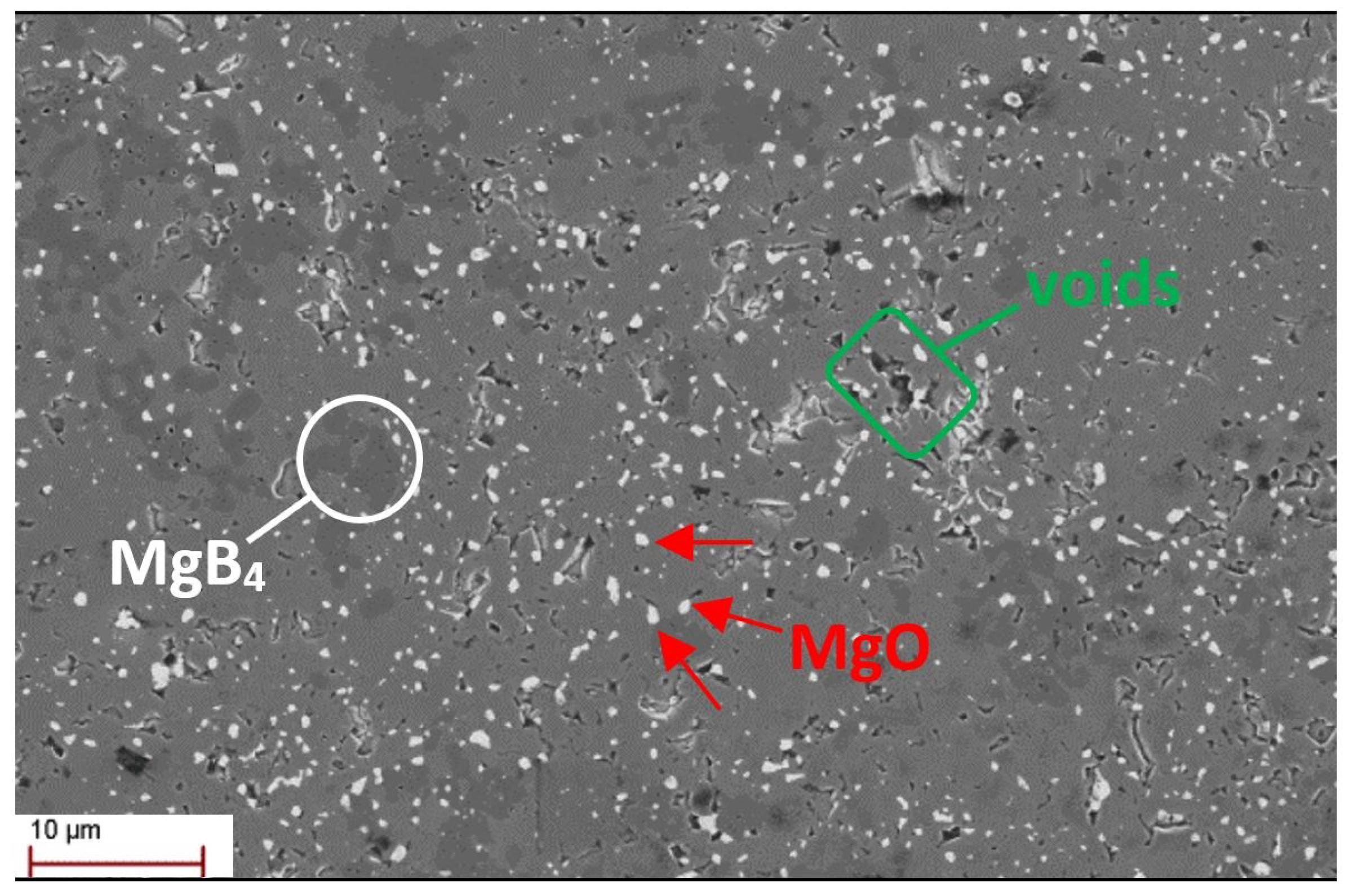
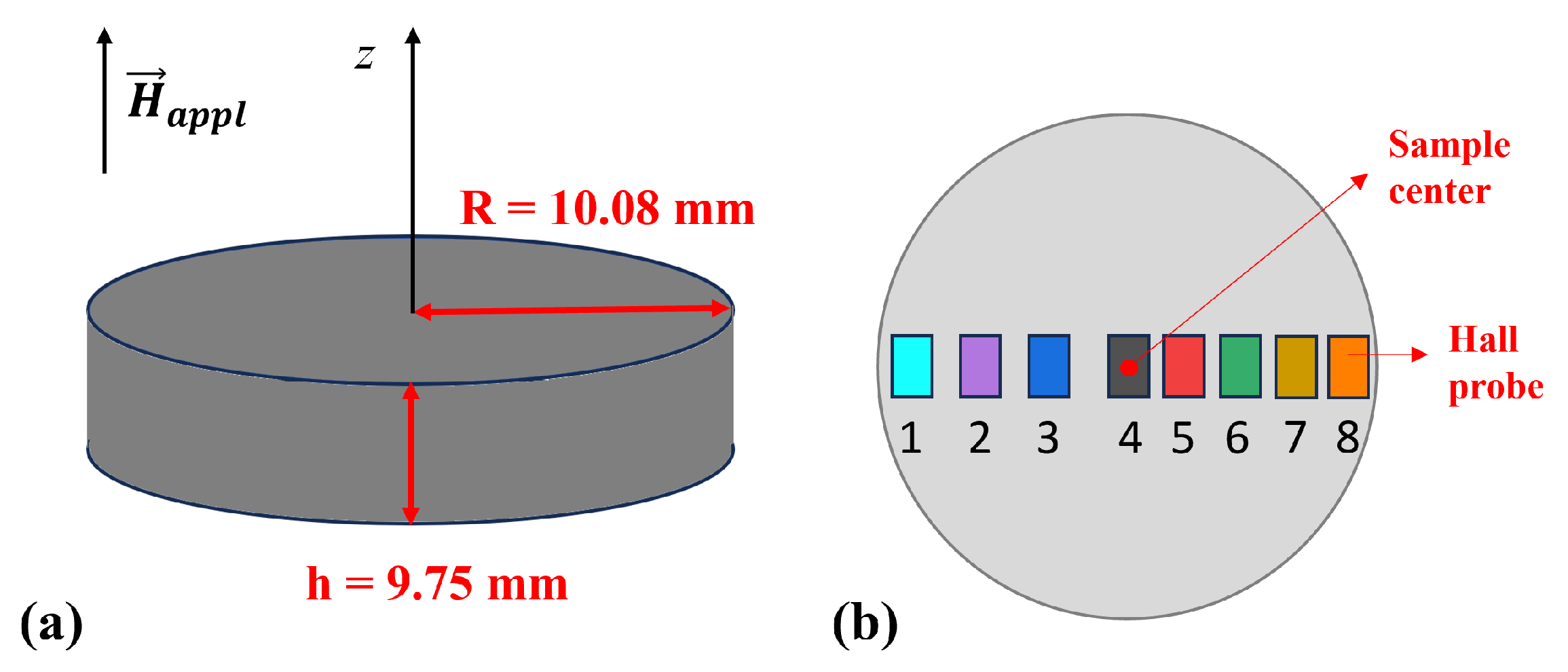
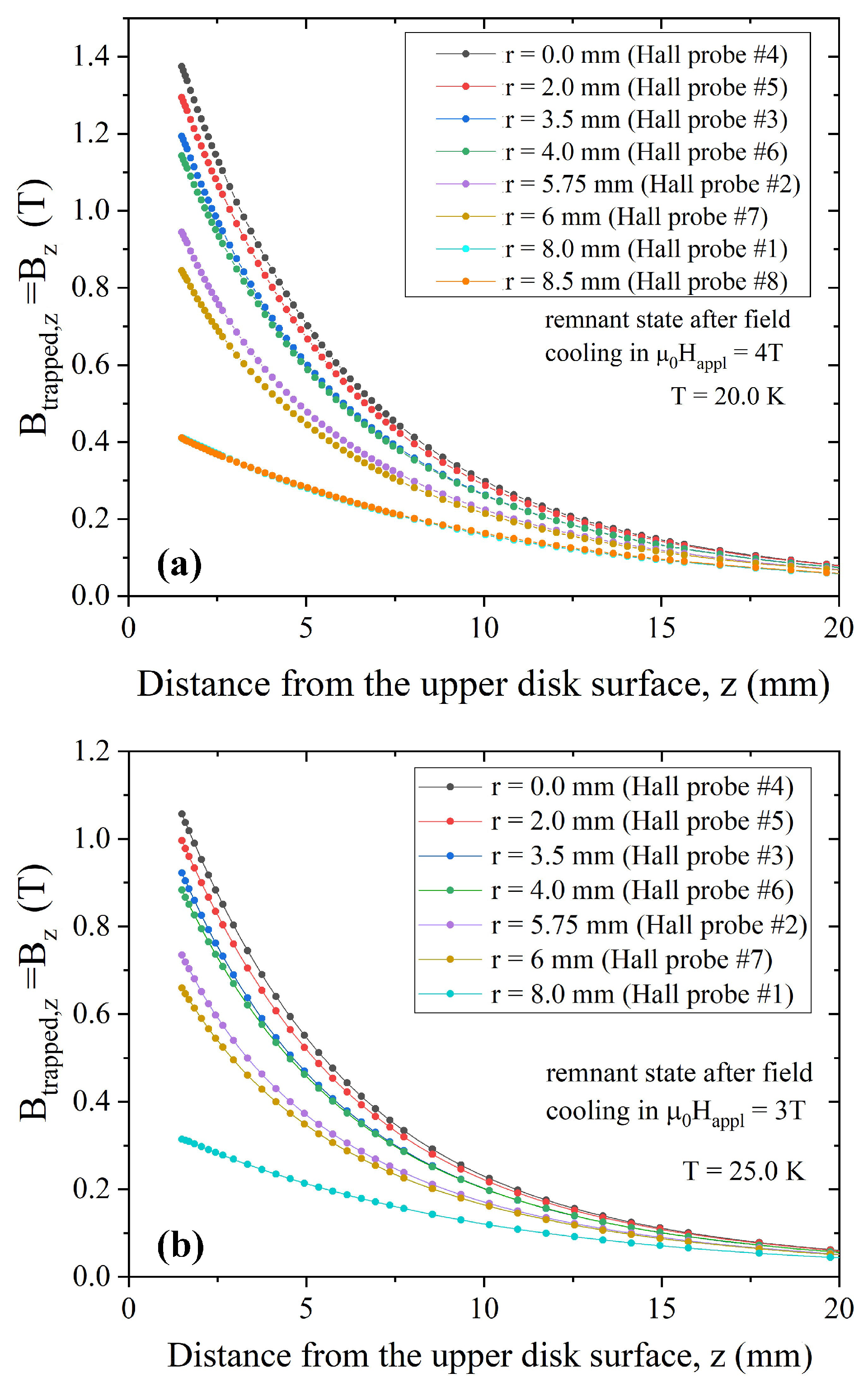
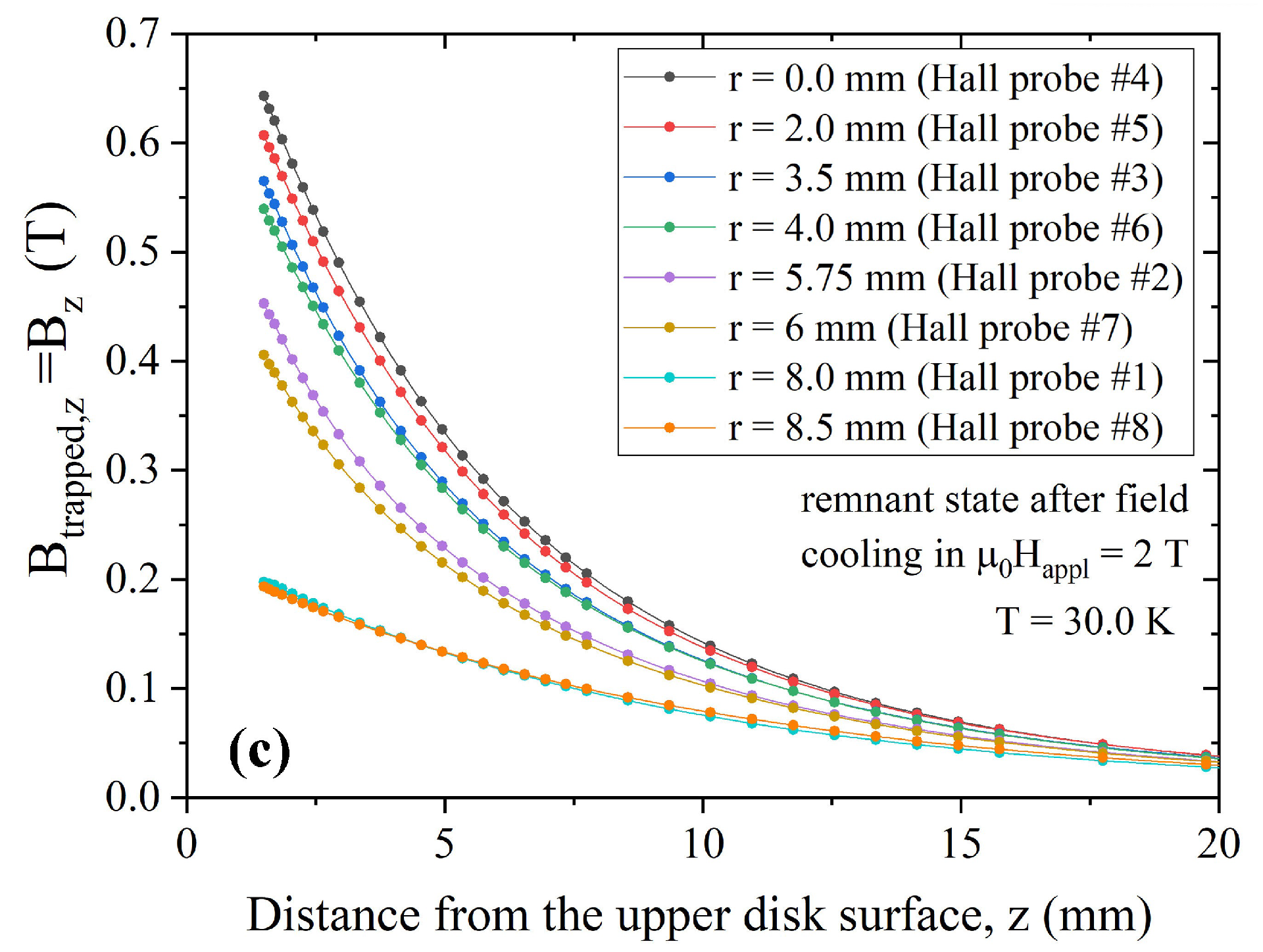
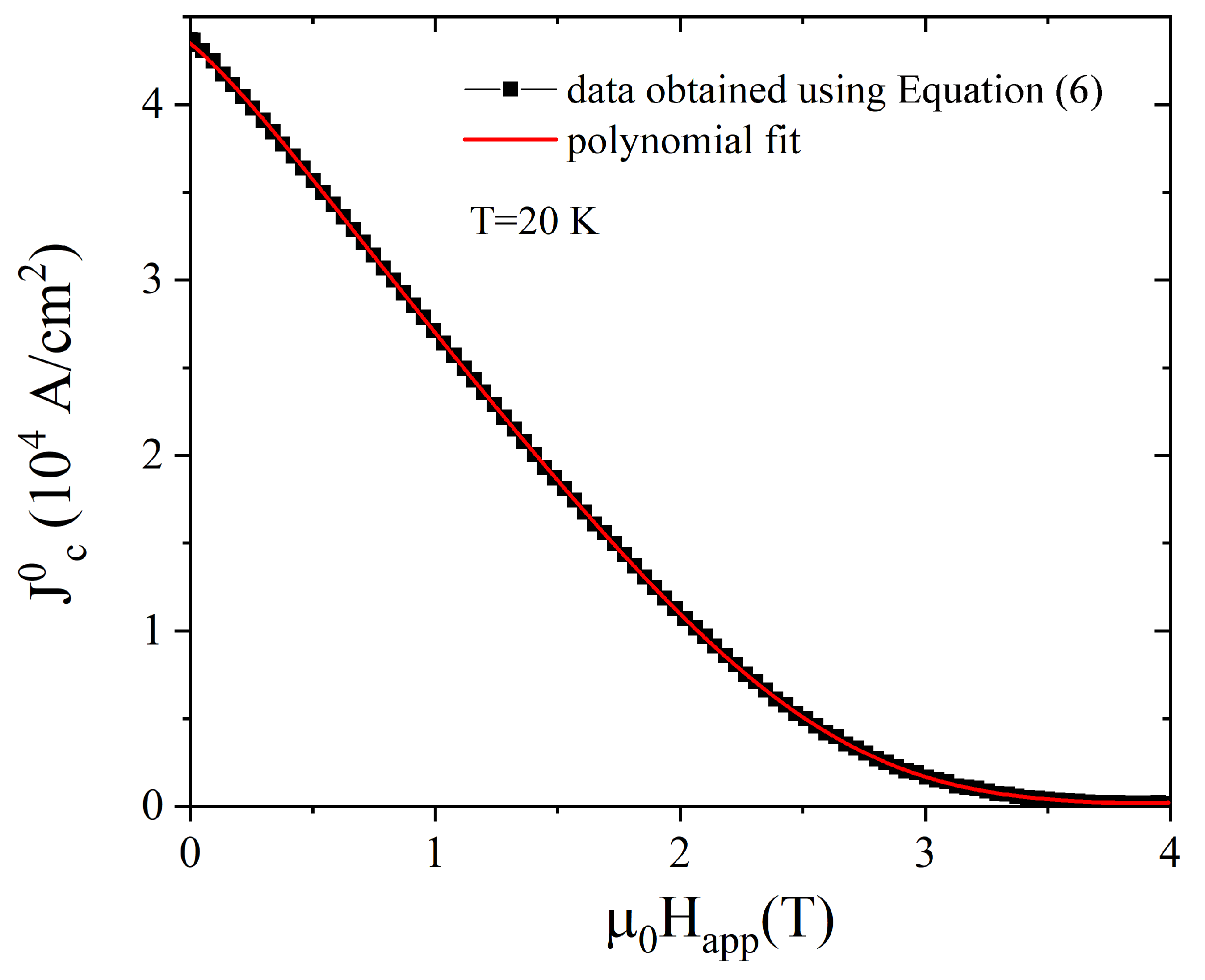

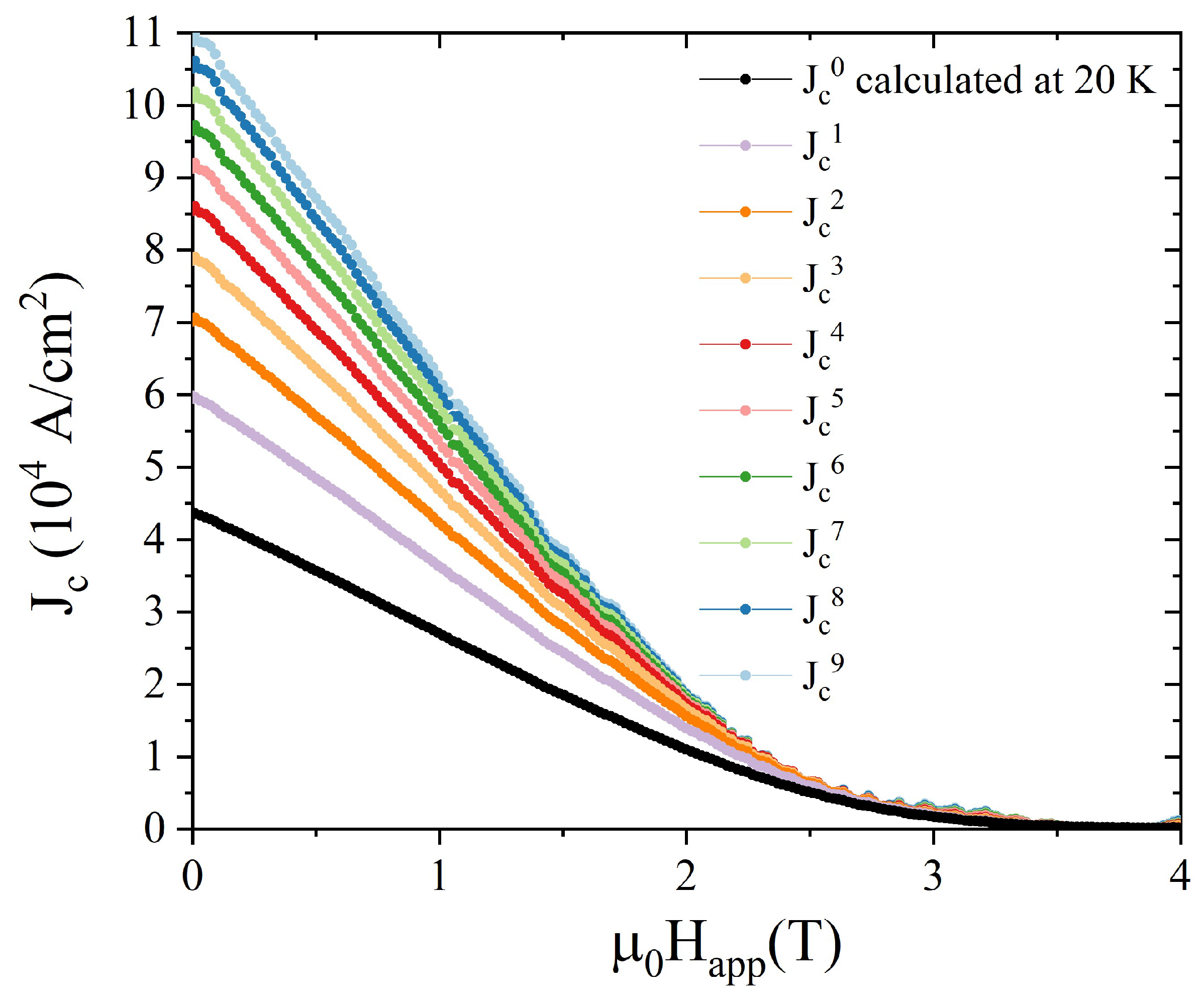

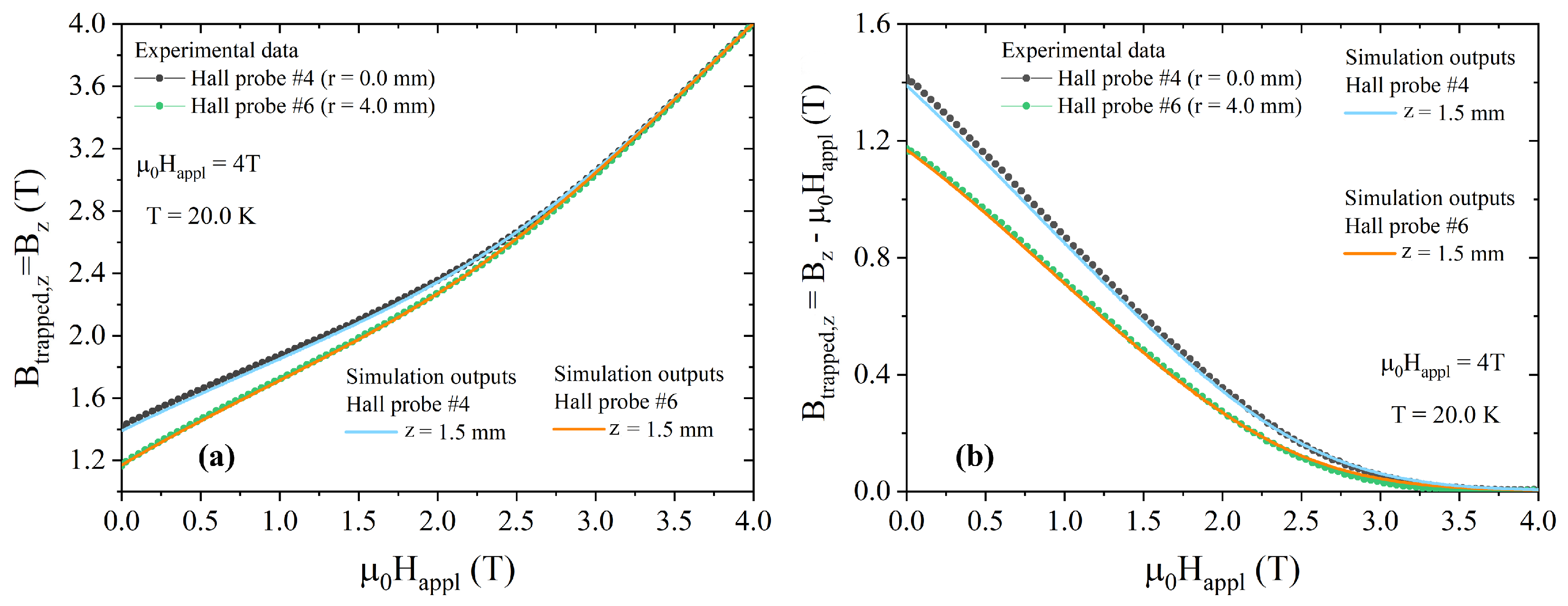

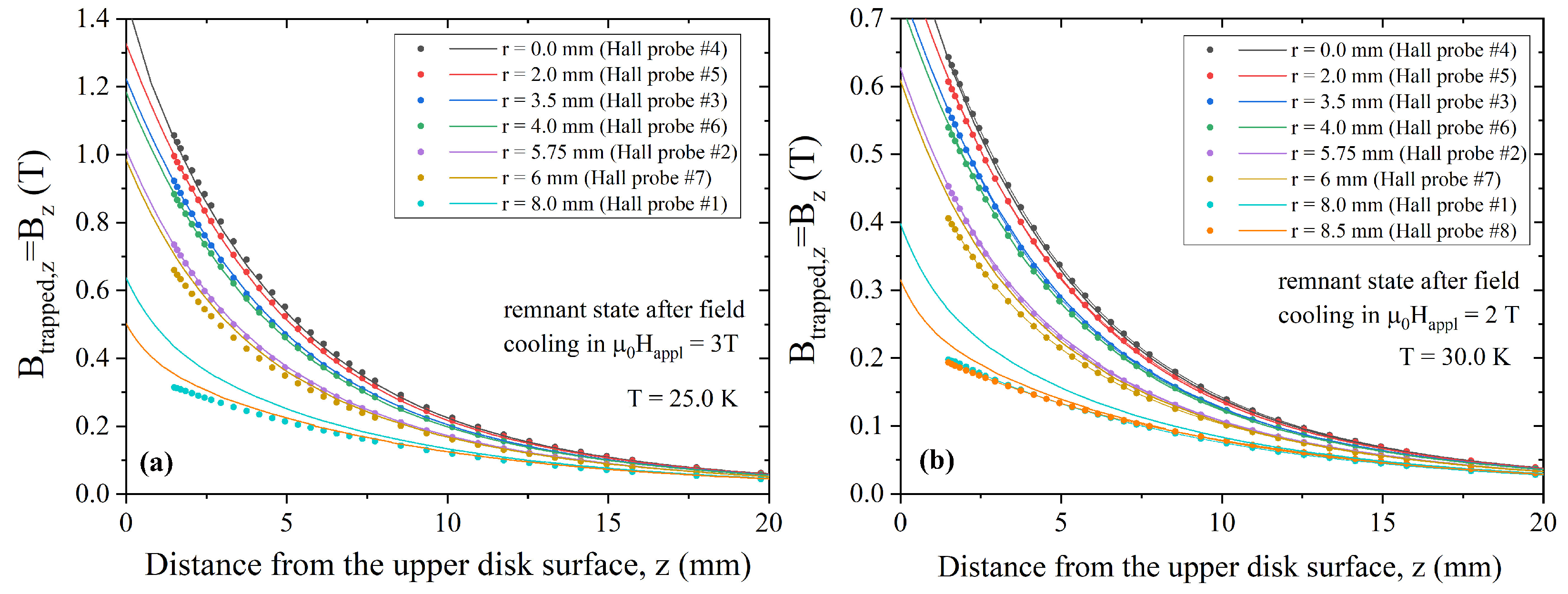

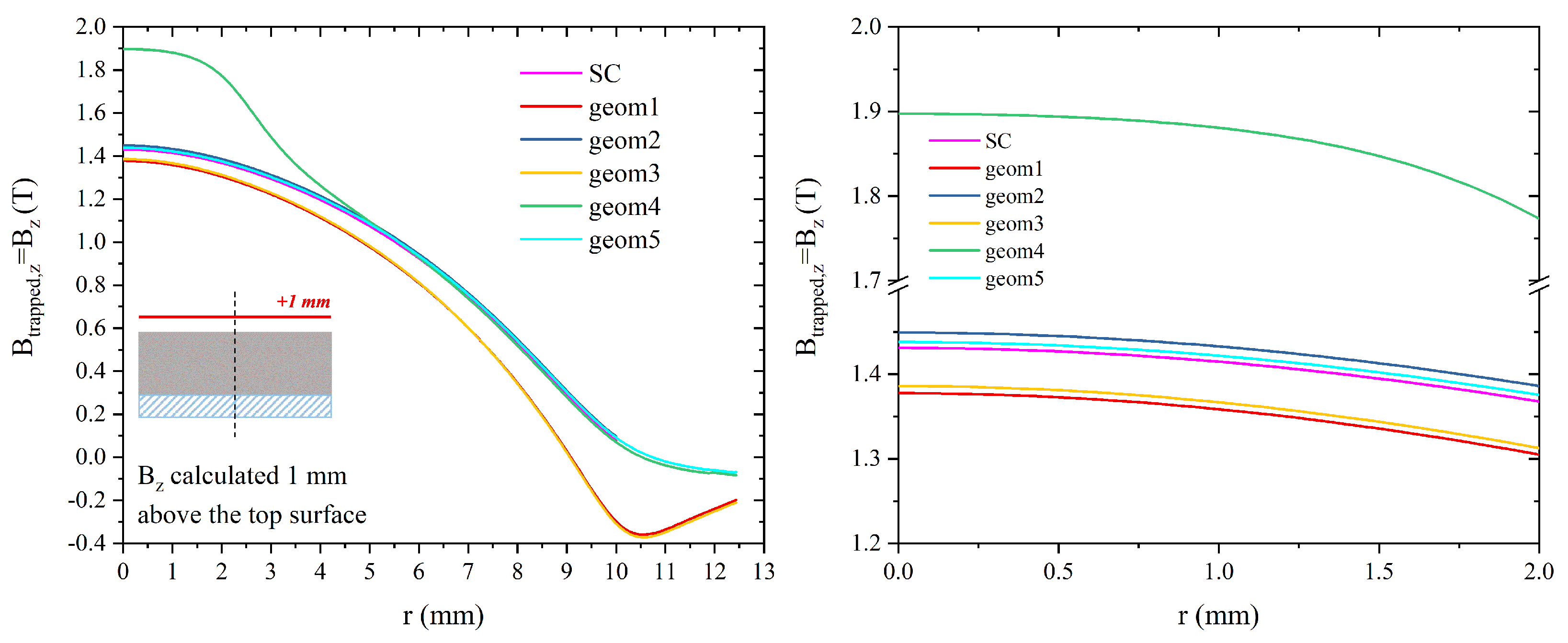

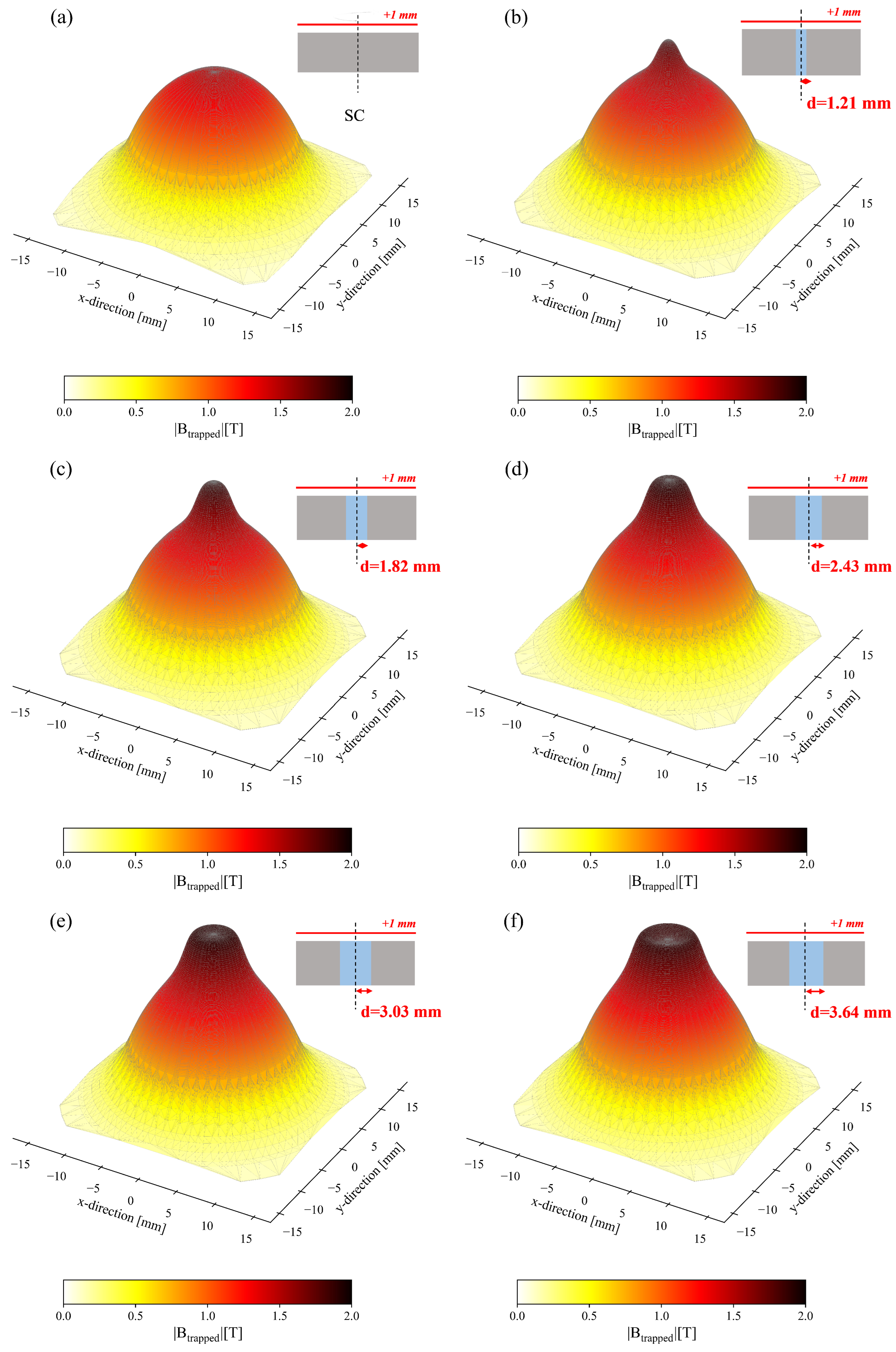
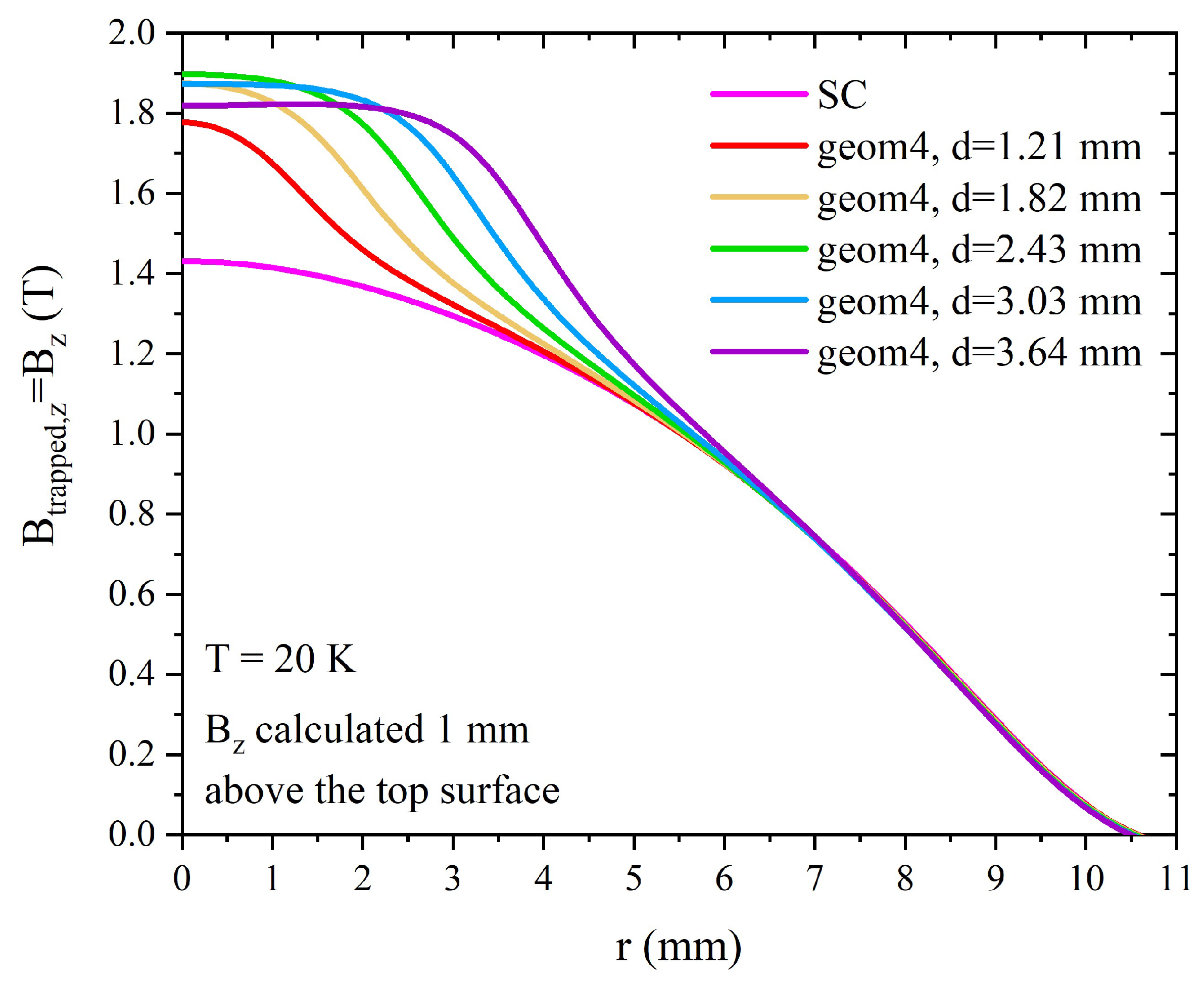



| T [K] | [A/cm2] | [T] | |
|---|---|---|---|
| 20 | 1.86 × 105 | 1.21 | 1.66 |
| 25 | 1.48 × 105 | 0.93 | 1.80 |
| 30 | 8.74 × 104 | 0.59 | 2.00 |
Disclaimer/Publisher’s Note: The statements, opinions and data contained in all publications are solely those of the individual author(s) and contributor(s) and not of MDPI and/or the editor(s). MDPI and/or the editor(s) disclaim responsibility for any injury to people or property resulting from any ideas, methods, instructions or products referred to in the content. |
© 2024 by the authors. Licensee MDPI, Basel, Switzerland. This article is an open access article distributed under the terms and conditions of the Creative Commons Attribution (CC BY) license (https://creativecommons.org/licenses/by/4.0/).
Share and Cite
Fracasso, M.; Gerbaldo, R.; Ghigo, G.; Torsello, D.; Xing, Y.; Bernstein, P.; Noudem, J.; Gozzelino, L. Comparison of the Field Trapping Ability of MgB2 and Hybrid Disc-Shaped Layouts. Materials 2024, 17, 1201. https://doi.org/10.3390/ma17051201
Fracasso M, Gerbaldo R, Ghigo G, Torsello D, Xing Y, Bernstein P, Noudem J, Gozzelino L. Comparison of the Field Trapping Ability of MgB2 and Hybrid Disc-Shaped Layouts. Materials. 2024; 17(5):1201. https://doi.org/10.3390/ma17051201
Chicago/Turabian StyleFracasso, Michela, Roberto Gerbaldo, Gianluca Ghigo, Daniele Torsello, Yiteng Xing, Pierre Bernstein, Jacques Noudem, and Laura Gozzelino. 2024. "Comparison of the Field Trapping Ability of MgB2 and Hybrid Disc-Shaped Layouts" Materials 17, no. 5: 1201. https://doi.org/10.3390/ma17051201
APA StyleFracasso, M., Gerbaldo, R., Ghigo, G., Torsello, D., Xing, Y., Bernstein, P., Noudem, J., & Gozzelino, L. (2024). Comparison of the Field Trapping Ability of MgB2 and Hybrid Disc-Shaped Layouts. Materials, 17(5), 1201. https://doi.org/10.3390/ma17051201







